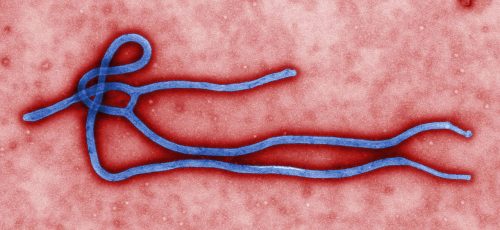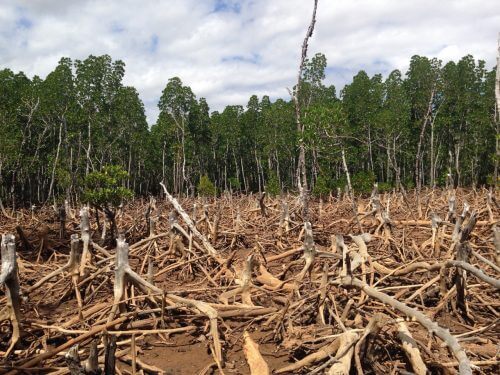A new study confirms: the Ebola outbreak in Africa is linked to the cutting down of the rainforests, which caused the bats carrying the virus to migrate towards the villages and cities in the region

By Racheli Vox, Angle, Science and Environment News Agency
Rows upon rows of graves that fill fields in West Africa stand as silent testimony to the deadliest outbreak of the Ebola disease, which raged in the region between 2016-2014 and claimed the lives of over 11 people. In those days, the members of the medical teams, sent by various governments in the world (including Israel), wrapped from head to toe in protective equipment against the deadly disease, arrived in the affected villages and cities. They sent children and adults whose family members fell ill and died into isolation, took bodies for safe burial in the face of the mourning screams and protests of their relatives, and tried to do everything they could in countries whose fragile health systems soon collapsed.
An Ebola outbreak usually starts from human contact with the carcass of an infected animal, often in remote rural communities. The exact mechanism of transmission of the disease from animals to humans is not entirely clear, but scientists believe that a main factor related to its spread is fruit bats - and that the animal is vaccinated against the disease but may transmit it to humans. There is evidence that other species may also be involved in the transmission of the virus, such as rodents, antelopes and monkeys.
According to the researchers' hypothesis, it is possible that when the fruit bats' natural environment - the forests - is destroyed, they find their way to human settlements in search of food. In this situation, there has been a significant increase in the amount of interaction between humans and the animals that are involved in the transmission of the disease. Newly discovered findings illustrate the strength of the link between deforestation and Ebola, revealing a possible new way to predict outbreaks of the disease.
Fatal excision
in research Published in the journal Scientific Reports, the Congo Basin was examined, a tropical rain forest that extends over large areas in central and western Africa. The researchers examined 27 populated sites where an Ebola outbreak began, as well as 280 random populated sites in the same area, where there was no Ebola outbreak. The researchers used satellite images to check the data of the forest census in these areas between 2014-2001, with each time the forest census was checked within a radius of 20 kilometers from the inhabited site: hunters usually move about 20 kilometers away from their villages, meaning that the area examined is the one where there are animals that carry the virus, humans might encounter them.

Deforestation, the process of felling or burning a large number of forest trees by man, is a serious phenomenon in which they have been destroyed until today More than half of the world's rainforests, mainly for agriculture, use of wood and cattle breeding. Previously available link between deforestation in West Africa and outbreaks of Ebola, but the researchers in the new study add the time dimension to the equation, showing that there is a very strong connection between forest loss and an Ebola outbreak in the same area two years later. The connection was strongest in the forests that were the densest, and in which the height of the trees was between 5 and 19 meters.
It is important to emphasize that this is not necessarily a causal relationship, that is, there is currently no proof that deforestation is the direct and sole cause of the Ebola outbreaks. However, this information is of great importance, and early knowledge of the possibility of an outbreak of the disease in a certain area will allow governments to allocate resources for the protection of its residents.
Ebola is a viral disease that causes severe bleeding. About 50 percent of people with the disease die from it, usually within a few days. The disease was first discovered in 1976, and its first outbreaks occurred in remote villages in central Africa, near tropical rainforests. The disease is highly contagious, even after death. It passes from person to person through the patient's secretions, therefore many of those infected are the patient's family members, who take care of him, as well as members of the medical staff. Ebola is not the only disease found to be associated with deforestation, and other diseases include Malaria and dengue fever.
Agriculture instead of trees
The Ebola epidemic joins a growing list of damage caused by deforestation in the world. "Deforestation causes enormous damage," says Prof. Uri Shains from the Department of Biology and Environment at the University of Haifa-Oranim. Deforestation causes the loss of many species, which disappear when their habitat disappears: approx. 80 percent of terrestrial species on Earth live in forests. The absence of trees to hold the ground often causessoil erosion. In addition, the drift also damages the water sources and may pollute them. "Deforestation causes floods, on a large scale it also causes a change in rainfall regimes, and of course it may cause a decrease in carbon sequestration", says Shanes. That is, the disappearance of the trees, which use carbon dioxide for their growth and survival, reduces the ability of the forests to absorb carbon dioxide from the atmosphere, thus indirectly causing an increase in the concentration of this greenhouse gas in the air and worsening the phenomenon of global warming.
The main reason for deforestation is the need for land for agriculture. Many forest areas are cleared in West Africa, in order to grow palm trees on their lands for the production of oil and cocoa trees. Therefore, when talking about stopping deforestation, it is impossible to ignore the populations that depend on agriculture for their survival. "The main thing is to find types of agriculture for which there is no need to create forests, to make agriculture more efficient and to be more efficient on the same lands that already exist," concludes Shanes. "It should be clear today that the world must find any way to stop deforestation, because we are deteriorating to places we cannot get out of."
